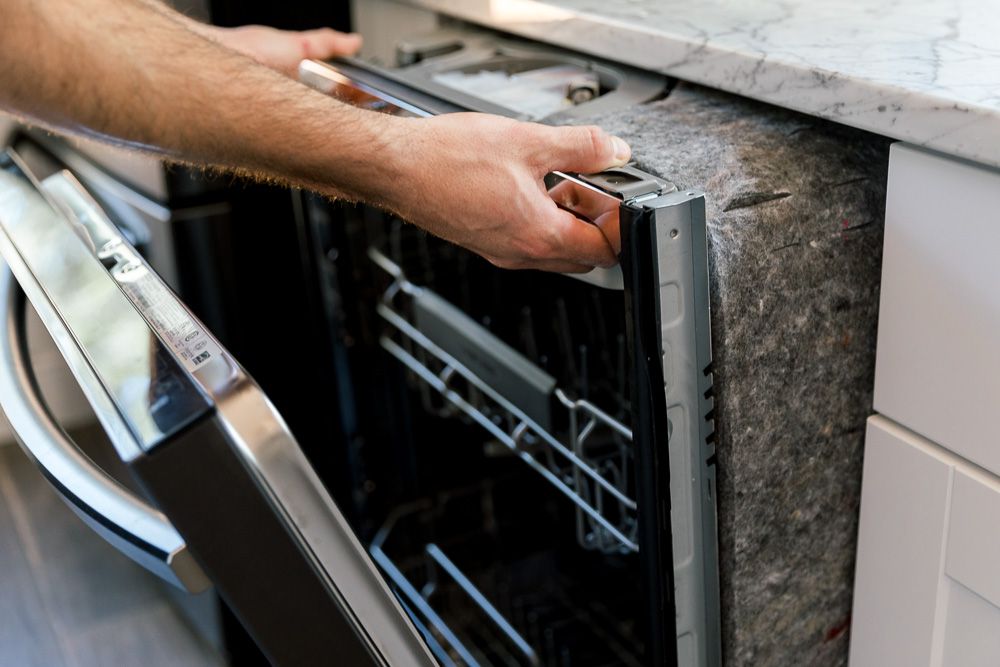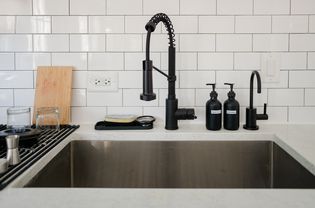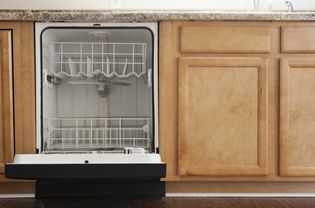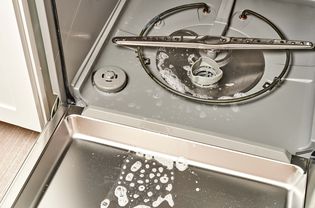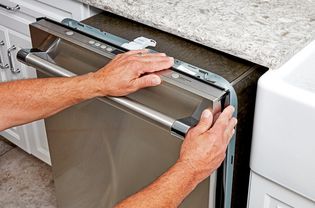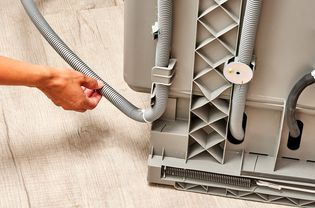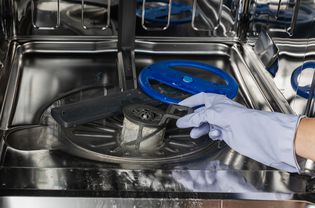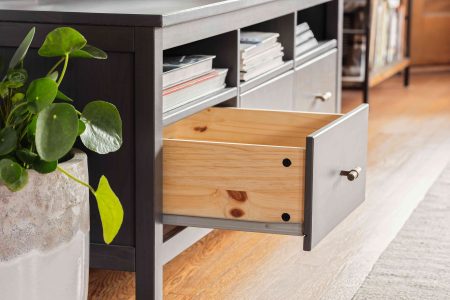How to Uninstall a Dishwasher in 5 Simple Steps
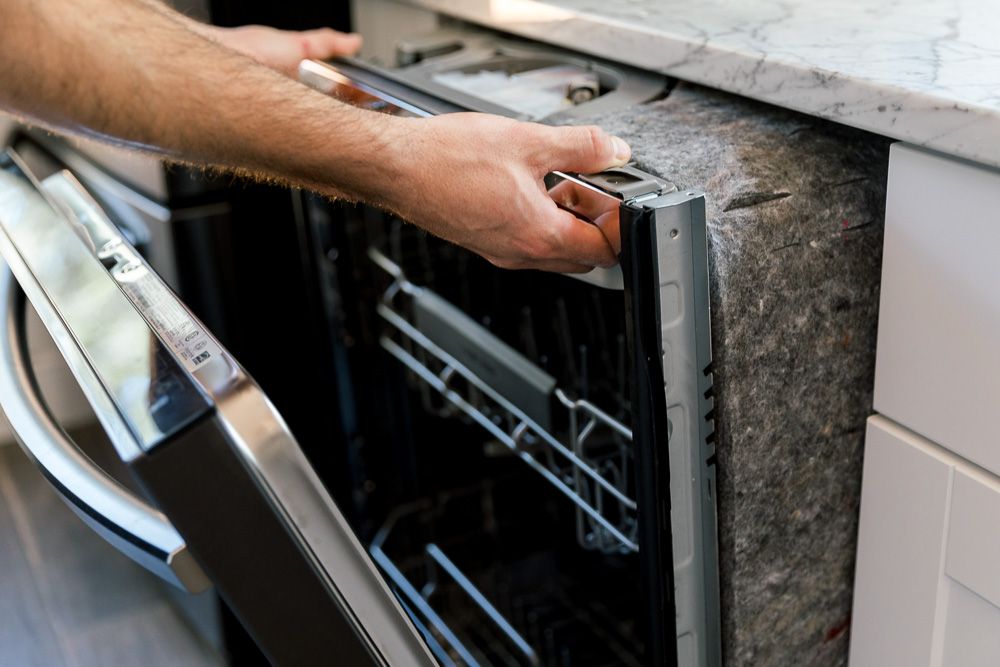
Although it can seem intimidating, installing a new dishwasher is well within the reach of most DIYers. But first, you must remove the old dishwasher, a task that involves disconnecting water and power connections, as well as dealing with the hardware bracketing that holds the dishwasher in place. Enlisting the aid of a helper will make this work easier, especially as you extract the appliance from the opening beneath the countertop.
Before You Begin
First, find the cord that provides power to the dishwasher and unplug it from the wall outlet. This wall outlet is often located under the sink.
Next, shut off the water. Locate the shutoff valve controlling the water line to the dishwasher. This will usually be located under the kitchen sink and will be attached to the hot water pipe, or to a two-way shutoff valve that controls water to both the faucet and to the dishwasher. If the dishwasher has been plumbed without a fixture shutoff valve, then you will need to turn off the home’s main water valve before disconnecting the water line.
Watch Now: How to Safely Disconnect and Remove a Dishwasher
Need more help? Talk to a dishwasher technician near you
Our partners can help you compare quotes from top-rated professionals near you
Get a Quote
What You’ll Need
Equipment / Tools
- Channel-lock pliers
- Screwdrivers
Materials
- Drop cloth (optional)
Instructions
-
Disconnect the Water Supply
Before you can remove the dishwasher, you will need to disconnect the two pipes that connect it to the plumbing system. The first of these is the water supply tube, which is usually a small copper or plastic tube covered with wire mesh that runs from the dishwasher location to the fixture shutoff valve.
If you have a dedicated shutoff valve, the source of the connection is clear. Use channel-lock pliers to disconnect the dishwasher supply tube from the outlet on the shutoff valve. This may be a single outlet valve, or a double-outlet valve if it controls the hot water to both the dishwasher and the sink faucet.
If the dishwasher has been plumbed without a fixture shutoff valve, then disconnection likely will involve unhooking the compression fitting or coupling nut that joins the dishwasher’s water supply tube to the hot water pipe.
-
Disconnect the Drain Line
The dishwasher is also tied into the plumbing system via a drain line. Locate the rubber hose coming from the dishwasher and trace it to the end connection. It may run upward to connect to an air gap fitting mounted to the sink or countertop. If so, loosen the clip or clamp holding the hose to the air gap, and detach the hose.
If the drain hose does not run to an air gap, it will terminate at a nipple fitting on the food disposer or sink drain tailpiece. If so, detach the hose at this point.
What Is an Air Gap?
The air gap is a safety device designed to prevent wastewater from siphoning back into the dishwasher and contaminating clean dishes. Good plumbing practice requires there to be an air gap, but in practice, it is sometimes omitted. If it is not present, you may notice that the drain hose has been looped up to a point near the top of the base cabinet under the sink and secured there. This is another option for preventing back-siphoning, but it is not nearly as effective as an air gap. When it comes time to install a new dishwasher, you will want to install the air gap fitting.
-
Unfasten the Mounting Brackets
A dishwasher is usually held in place by a couple of metal mounting brackets screwed into the bottom of the countertop above the dishwasher. Open the dishwasher door and look under the lip of the kitchen counter to find these brackets. Remove the screws holding the dishwasher in place.
-
Lower the Dishwasher
Before the dishwasher can be moved out of its location, you will need to lower it by unscrewing the legs.
Start by removing the faceplate that is located on the lower part of the dishwasher face. Sometimes there are mounting screws that hold it in place; on other models, the faceplate may be held in place with simple spring clips.
Once the faceplate is removed, you will see the legs of the dishwasher. Twisting the threaded legs clockwise will lower the body of the dishwasher. Lower it down as low as it will go to create space between the top of the dishwasher and the bottom of the countertop.
-
Remove the Dishwasher
Slide the dishwasher out of its cabinet by carefully pulling it straight out of the cabinet. You will most likely need to lift it slightly to clear the edge of the floor covering since the dishwasher usually sits directly on the subfloor. It can help to have a helper under the sink carefully feed the water supply tube and drain hose through the hole in the cabinet wall as you pull the appliance out from under the countertop.
To avoid scratching the floor, lift slightly as you pull the dishwasher out of the cabinet. You may want to protect the flooring with a canvas drop cloth as you extract the appliance.
You are now ready to install a new dishwasher.
When to Call a Professional
In rare instances, you may find that your dishwasher has been “hard-wired” into an electrical circuit; it is not plugged into an outlet at all. In this case, the disconnection involves turning off the circuit breaker controlling power to the dishwasher, then disconnecting the circuit wires inside the dishwasher’s wire connection panel, located behind the access panel at the lower front of the appliance. Unless you have experience with electrical work and are confident in your skills, this may be best left to a professional.
-
Is it hard to uninstall a dishwasher?
Uninstalling and removing an old dishwasher is a doable task for DIYers with some knowledge of how the appliance is hooked up. It’s best to complete this task with at least one other person.
-
Do you need to turn the water off to remove a dishwasher?
There should be a valve that shuts off water to the dishwasher, so you don’t have to completely shut off the building’s water. However, if the valve is damaged or nonexistent (which is rare but possible), then you’ll need to turn off the main water supply.
-
What do you do with the space after removing a dishwasher?
If you’re not looking to install a new dishwasher after you remove an old one, there are several ways to make use of that space. You can add cabinetry that matches the rest of the kitchen or create custom shelving, for example. It also can be a good spot for a trash can or rolling storage containers.
Read the full article here



